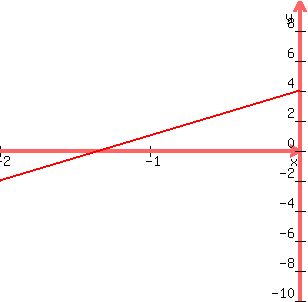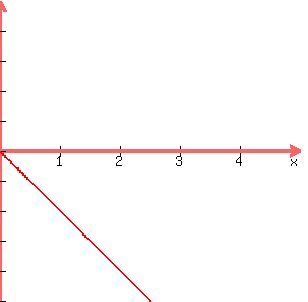Question 1124548: Please show me step by step about this question. Iím preparing for my 1st out 4 exams on my math class in a week today.
Hereís the question: for the following piecewise functions, graph, state, domain, range and intercepts
F(x)=3x+4 if-2<=x<0
-3 if x=0
-2x if x>0
Thanks!
Found 2 solutions by Boreal, Theo:
Answer by Boreal(15235)   (Show Source): (Show Source):
You can put this solution on YOUR website! From -2 to 0 with 0 open, the graph is 3x+4, up and to the right, with domain -2 to 0 and range -2 at the left end to 4 open at the right end. There is an x-intercept at -4/3.
at x=0, y=-3, which adds a point to the range and nothing to the domain. It is the y-intercept.
at x>0, it is -2x, which makes the range from 0 to - oo for this part, and therefore makes the whole range from -oo to 4 open. The domain is x from -2 to +oo.


At 0, the function is -3, and that is a solid point. There should be an open point for the two lines at x=0.
The domain is [-2, oo)
The range is (-oo, 4]
The x-intercept is at (-4/3, 0).
The y-intercept is at (0, -3).
While there is a second "crossing" of the x-axis, it is a jump and not a point.
Answer by Theo(13342)   (Show Source): (Show Source):
You can put this solution on YOUR website! your piece-wise functions are:
F(x)=3x+4 if-2<=x<0
-3 if x=0
-2x if x>0
the first of them is f(x) = 3x + 4 if -2 <= x < 0
let y = f(x).
the equation becomes y = 3x + 4 if -2 <= x < 0
the domain is all real values of x such that -2 <= x < 0
the range is all real values of y then x is equal to -2 all the way up to when x is < 0.
when x = -2, y = 3x + 4 = -2
when x = 0,y = 4
the range is therefore all real values of y such that -2 <= y < 4
the x-intercept is the value of x when y = 0.
when y = 0, the equation becomes 0 = 3x + 4
solve for x to get x = -4/3.
the x-intercept is -4/3, which is the point (-4/3, 0)
the y-intercept is the value of y when x = 0.
since x can't be equal to 0, there is no y-intercept.
the second of them is f(x) = -3 if x = 0.
let y = f(x) and the equation becomes y = -3.
the domain is all real values of x such that x = 0.
in other words, the value of x can only be 0.
the range is all real values of when hen x = 0.
the range is therefore all real values of y such that y = -3
in other words, the value of y can only be -3.
the x-intercept is the value of x when y = 0.
since y can't be equal to 0, there is no x-intercept.
the y-intercept is the value of y when x = 0.
the y-intercept is therefore y = -3 which is the point (0,-3).
the third of them is f(x) = -2x when x > 0.
let y = f(x) and the equation becomes y = -2x when x > 0
the domain is all real values of x such that x > 0
the range is all real values of y when x > 0.
when x = 0, the value of y is -2 * 0 = 0.
but y can't be equal to 0 because x can't be equal to 0.
when x > 0, the value of y = -2x.
x will always be negative and can never be equal to 0 because x can never be equal to 0.
the range is therefore all real values of y such that y < 0.
if you graph these equations, they will look like this.

the open circle means the line goes up to but does not include that point.
the closed circle means the line goes up and and includes that point.
|
|
|